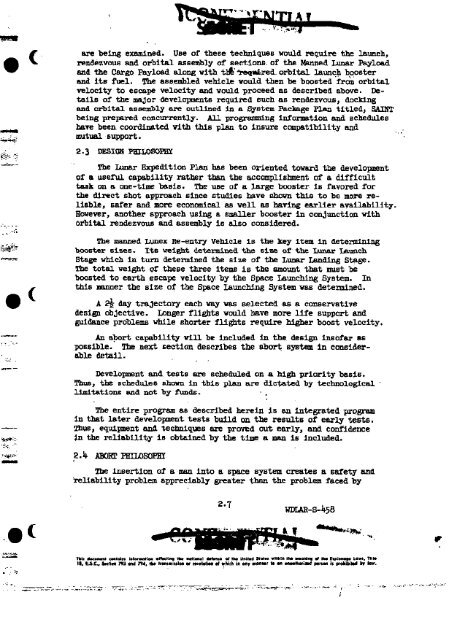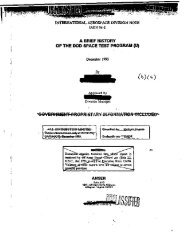LUNAR EXPEDITION PLAN
LUNAR EXPEDITION PLAN
LUNAR EXPEDITION PLAN
You also want an ePaper? Increase the reach of your titles
YUMPU automatically turns print PDFs into web optimized ePapers that Google loves.
are being examined. Use of these techniques would require the launch,<br />
rendezvous and orbital assembly of sections, of the Manned Lunar Payload<br />
and the Cargo Payload along with tde' -required. orbital launch booster<br />
and its fuel. Ike assembled vehicle would then be boosted from orbital<br />
velocity to escape velocity and would proceed as described above. Details<br />
of the major developments required such as rendezvous, docking<br />
and orbital assembly are outlined in a System Package Plan titled, SAINT<br />
being prepared concurrently. All programming information and schedules<br />
have been coordinated with this plan to Insure compatibility and<br />
mutual support.<br />
2.3 DESIQN PHILOSOPHY<br />
The Lunar Expedition Plan has been oriented toward the development<br />
of a useful capability rather than the accomplishment of a difficult<br />
task on a one-time basis. The use of a large booster is favored for<br />
the direct shot approach since studies have shown this to be more reliable,<br />
safer and more economical as well as having earlier availability.<br />
However, another approach using a smaller booster in conjunction with<br />
orbital rendezvous and assembly is also considered.<br />
The manned Lunex Re-entry Vehicle is the key Item in determining<br />
booster sizes. Its weight determined the size of the Lunar Launch<br />
Stage which in turn determined the size of the Lunar Landing Stage.<br />
The total weight of these three Items is the amount that must be<br />
boosted to earth escape velocity by the Space Launching System. In<br />
this manner the size of the Space Launching System was determined.<br />
A 2^ day trajectory each way was selected as a conservative<br />
design objective. Longer flights would have more life support and<br />
guidance problems while shorter flights require higher boost velocity.<br />
An abort capability will be included in the design insofar as<br />
possible. The next section describes the abort system in considerable<br />
detail.<br />
Development and tests are scheduled on a high priority basis.<br />
Thus, the schedules shown in this plan are dictated by technological *<br />
limitations and not by funds.<br />
The entire program as described herein is an integrated program<br />
In that later development testB build on the results of early tests.<br />
Thus, equipment and techniques are proved out early, and confidence<br />
in the reliability is obtained by the time a man is included.<br />
2.1* ABORT PHILOSOPHY<br />
The insertion of a man into a space system creates a safety and<br />
reliability problem appreciably greater than the problem faced toy<br />
HDIAR-S-45B<br />
TMi fcHM caaraim tnfsriMltoi •ft.tiine MM MtlsiHl MMIM sf W Unitad Rain wMitn Hn aaanlna at tfc* EwionoM tawi, Tiltt<br />
II, U.S.C., fcttlen 7*3 and 7W, tfc* honnnrulw at nutlatiM af «hi(h in any mennti fa m MaaHiaiiiMf paim It prahlblM be low.<br />
i




